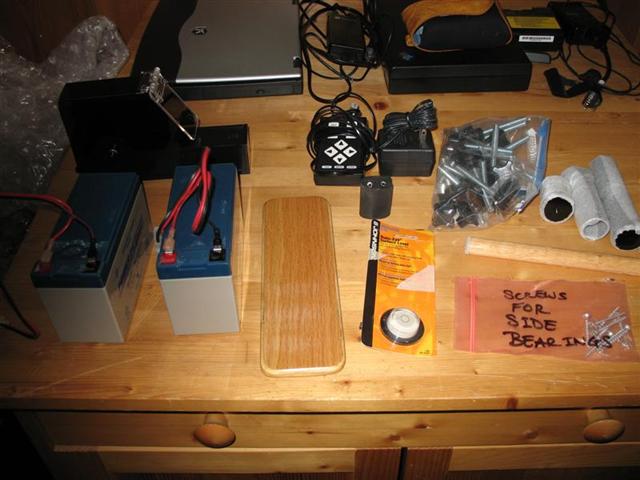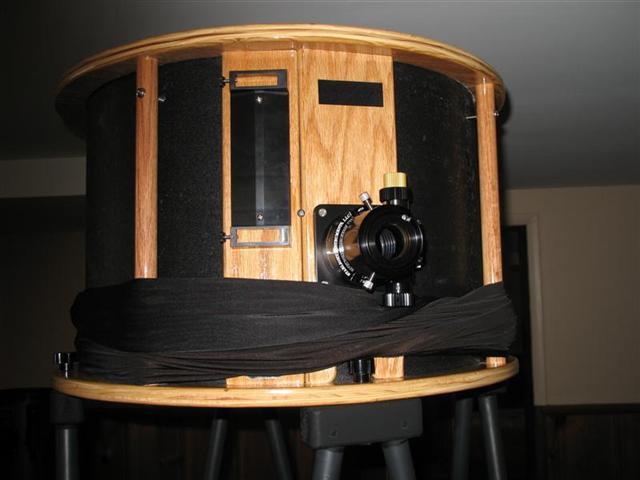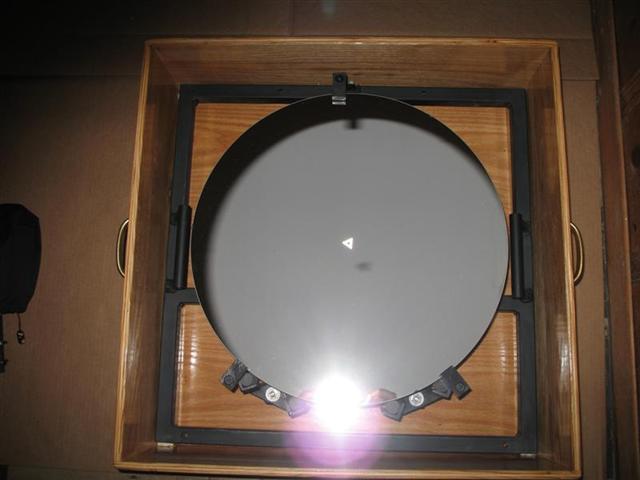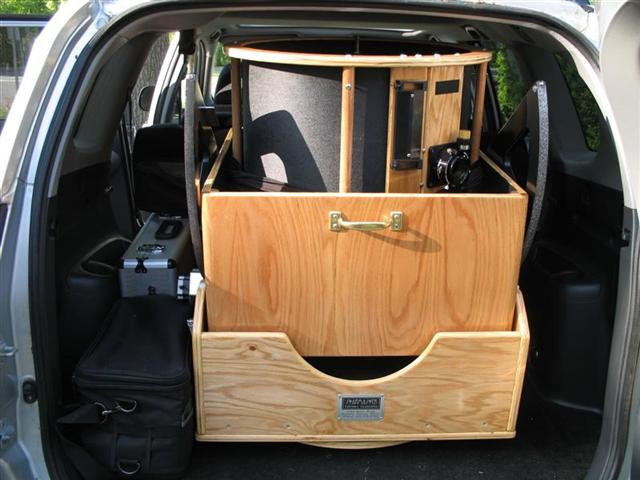May 8, 2008 (updates here)
Earlier this year, I put in an order for one of the new Starmaster 18" FX (f/3.7) telescopes. It arrived last week, and I was able to get it
out under some decent skies Sunday and Monday nights. Bottom line: I
had pretty high expectations, which were exceeded. I’m looking
forward to using the scope more extensively, under really dark skies,
in the near future. But I thought there might be some interest in some
initial reactions.
The scope arrived, safe and sound, in eight boxes. Assembly was a breeze.






By the second night, it was already easy to get set up quickly
in the field--and more importantly, easy to break down efficiently in
the dark. The checklist from the manual, for what to do in what order,
was a welcome confidence booster at 3am. The mirror cell is ingenious
and exquisitely balanced.

The first time I eased the primary into the
mirror box, I just smiled at how effortless it was.
I got the Sky Tracker, which is elegantly simple, and it worked well on
the first night. On the second night, it worked even better. I had a
slightly more level spot for the rocker box, and my two-star alignment
for the sky commander was a little more careful. At one point, I was
using a 7mm Nagler quite a bit--already a good sign--and checked to see
if a moderately long slew would still put a target within the field of
view (less than 1/3 of a degree). It did. Using a Panoptic 22 made
finding almost too easy. During a short window of quite good seeing on
the second night, it was also possible to push Saturn up to about 675x,
and this required only occasional keypad nudges to keep the target
centered. At about 400x, Saturn stayed well within the field of view
for long stretches...long enough to walk away, chat to someone, come
back and share the image. But as nice as the tracking is, it’s
also nice to push a dob around. So I was delighted to see (and feel)
just how simple it is to disengage the motors. The azimuth clutch is
very accessible and super easy to move. Wandering through the Virgo
cluster "manually" with an 18 inch mirror, with feet firmly on the
ground, was just sheer fun.
The eyepiece height is 69" at zenith. I’m about 71". So for me,
even on the rare occasion when scope is pointing straight up, the
footrest of my observing stool (Stardust) is the only needed boost.
More importantly, in my view, a lot of sky can be seen while seated;
and the rest can be seen standing upright, like an actual human being.
No ladder, no stooping. This was a big factor in my thinking, when I
decided to buy the scope. But even so, I had underestimated how much
difference this would make to overall comfort as the evening went on.
Likewise, while I knew that the combination of sitting and good
tracking would improve observing, I had underestimated how significant
the effect would be. The sombrero galaxy drove the point home for me.
My first look was certainly nice. But while it seemed clearly brighter
than I was used to, from my ten inch dob under comparable skies, the
detail wasn’t yet dramatically better. Though once I sat down,
took a breath and looked again--head steady, and the galaxy fixed in
the center of the field of view--the dark lane and other details
emerged far better, almost immediately.
Of course, this whole lovely idea--an 18" mirror connected to an
eyepiece that never goes higher than 69"--requires a mirror maker who
is able and willing to produce an f/3.7 of high quality. The mirrors
for the new “FX” telescopes are from Mike Lockwood, who has
a reputation for excellent work and a talent for fast mirrors. (Lockwood is
also testing the secondaries, and refiguring if necessary.) From what I saw
on my first two nights, his reputation is well earned. Unsurprisingly,
seeing didn’t permit a thorough star test at the mirror’s
theoretical limit. But at one point, the seeing became pretty good for
the east coast while Vega was reasonably high. This made it hard to
resist a quick little test, especially given the tracking: Vega wasn't
budging from dead center. I don't claim any expertise in this area, but
the images as I racked in and out sure looked impressive, given what I
do know; near to the textbook pictures. And this meshed with what I saw
when the power was cranked up on Saturn: very clear C ring, along with
obvious divisions in cloud bands. (These features were also immediately
noticed and commented on by a long-time observer, also at the site, at
lower power during a period of less good seeing. By the way, Starmaster
woodworking was also a topic of comment; all present were much in
favor, as is my wife.)
Being able to sit certainly helped. But only on the most exceptional
nights have I had the chance to see a similar level of planetary detail
while sitting down--once through a Starmaster 14.5 (with a Zambuto
mirror) on top of Spruce Knob in West Virginia. To repeat, I
don’t have any special knowledge when it comes to evaluating
mirrors. So it’s not that I really trust own my own judgment
here, especially after only two nights. But what I saw fits with my
expectation that Mike Lockwood would produce an excellent mirror--and
that Rick Singmaster wouldn’t risk his reputation by working with
a new optician who didn’t produce excellent mirrors...much less
ship a subpar mirror to an owner, who is likely to take the new product
to star parties.
I’ll refrain from listing all the other objects observed. But my
first look at M5 actually made me gasp, and step back from the
eyepiece. Views of the ring nebula were like those I would have
expected from a larger telescope.
Getting and keeping precise collimation was surprisingly easy, once I
got a feel for how the secondary moved, and how to make it snug. And
during sessions, all I needed was a small tweak with a laser (barlowed
for the primary) after about 90 minutes of moving around. The primary
mirror held collimation exceptionally well: one tiny turn per night was
all it needed, despite a lot of slewing around--more than I would do in
a regular session--in the course of trying out the GoTo system.
As for coma, the Paracorr did its thing. At f/3.7, a Paracorr is of
course nonnegotiable; with/without shots could have been an ad for
Televue. When I really put my mind to it, I did manage to detect a
little coma at the edge of a Panoptic 22, and just a smidgeon way at
the edge of an Ethos 13. But I don't expect to be devoting lots of
mental energy to detecting the slightest coma at the edges, especially
with the Ethos. And the wide coma-corrected field of view provided by
the Ethos (about 2/3 of a degree at about 150x)...wow...just a whole
new experience of familiar Messier objects. (As everyone has been
saying, the Ethos is wonderful. And unsurprisingly, you can make very
good use of it with the Lockwood mirror.) I found that the Paracorr was
useful even with a Nagler 7--yielding about 275x, exit pupil 1.6--and
that I wanted to go Paracorr-free only when using a barlow to get the
very high powers on Saturn.
I also tried a Panoptic 35, which yields a high exit pupil (8.2)--but
no secondary shadow, in a field of just over a degree. Still finding
this a bit hard to get my head around: a full degree field of view,
with an 18" mirror, without stepping up to the eyepiece. I’m
looking forward to panning around the Milky Way this summer, even if
some will complain that I’m “wasting” light. (Though
I will pan slowly: for me, the 35 exhibited enough pincushion effect
that quick panning gave me the slightly queasy feeling I’ve heard
about, but hadn’t yet experienced. But going slow was just
fine. One could make a case for a Nagler 26 or 31, as the
“ideal”
large eyepiece for this telescope. Though I have no desire to buy one,
and then hear about a new Ethos in production.)
In short, with regard to collimation and coma with the fast mirror: not
an issue, given the now standard collimation tools/techniques and a
Paracorr. This was my first time using an autocollimator, and it was
easy. With regard to transport, I was able to get everything--and I
mean everything...the stacked scope components, the primary mirror in
its transport box, trusses, two cases with eyepieces and other gear,
and an observing stool–into the back of a Toyota RAV4 with one of
the backseats up and still completely unoccupied, with room to spare in
the cargo area (for more equipment, or a tent and sleeping bag).


 (That's an Orion 10" dob, in the back, for a size comparison.)
(That's an Orion 10" dob, in the back, for a size comparison.)
As will be obvious, I’m very happy with this telescope after the
first couple of nights out. I’ll add to these remarks once
I’ve had the scope out under dark skies...weather permitting, at
Cherry Springs at the end of this month...I'll also try to add some
outdoor photos, of the
telescope and eventually with it.
updates Back to my Home Page